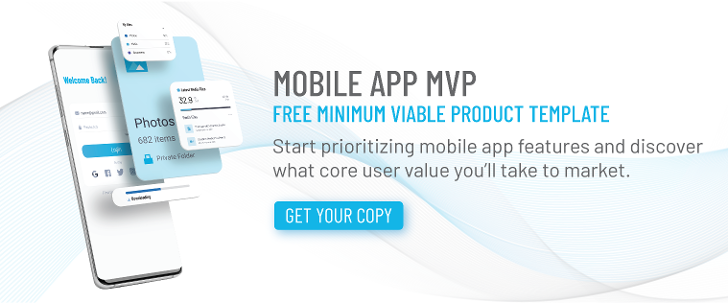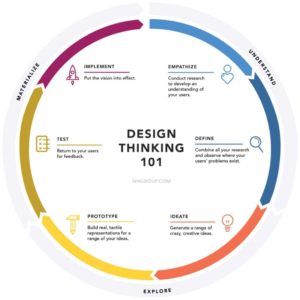The terms user experience (UX) and user interface (UI) have become inadvertently misused throughout the mobile app development community. The user experience, however, is not the same thing as the user interface. This confusion most likely stems from the overlap of the skill-sets and tools involved in both disciplines, such as the design thinking methodology.
The truth is, it’s nearly impossible to extract one discipline from the other. While the UX is a combination of tasks focused on the optimization of a mobile app for effective and enjoyable use, the user interface design is its counterpart – the look and feel, the presentation, and overall interactivity of a product.
UX design helps users accomplish functional tasks across platforms and services. Meanwhile, UI design consists of compelling and aesthetically pleasing interfaces for user interaction. UX and UI designers work in the same realm and on the same projects, but apply separate skills at various stages of development.
Let’s get deeper into the weeds to discover the differences.
What is User Experience?
“User experience” (UX) is exactly what it sounds like. UX describes the overall experience users have when interacting with your product. Cognitive scientist Don Norman is credited with coining the phrase in the early 1990s while working at Apple. He defines UX as:
“User experience” encompasses all aspects of the end-user’s interactions with the company, its services, and its products.
That’s a fairly broad definition, but basically UX deals with the emotional experience a user has with a product; design decisions should be based solely on the needs and wants of the user. That means a user’s experience isn’t just about the practical usage of an app or system, but their overall experience with your brand, from start to finish.
UX, or UXD, involves everything that influences a user’s perception and interaction with a product. In technical terms, UX is the practical, experiential, meaningful, affective, and valuable characteristics of human-machine interaction. Mobile UX encompasses the user’s perceptions and feelings before, during, and after their interaction with an app.
All that means that a UX designer’s primary concern is to address the feel of a product for a set of users. To accomplish this, UX designers explore different options to solve user-specific pain points and provide users with a valuable solution. Ultimately, products with good UX are user-friendly and straightforward.
Why is UX Design Important?
Overall, a mobile app’s UX impacts how users perceive the product. Users search for apps that provide value, are easy to use and will help them fulfill a goal. The UX determines if a user will return to your app or if they will delete it altogether. If the UX is bad, you might even be in for a poor review.
According to UX Designer Nick Babich, “The best products do two things well: features and details. Features are what draw people to your product. Details are what keep them there.”
For this reason, UX designers generally focus on:
- Product structure, such as navigation, user journeys, and flow.
- User, competitor, and market analysis research.
- Testing with low- and high-fidelity prototypes.
- Wireframes, hierarchy, and content layout designs.
What Makes A Great User Experience?
Successful mobile apps all have one thing in common: they benefit their users. If a person is going to use an app repeatedly, the product needs to not only be useful, but offer ongoing value. Creating an amazing UX begins with following the design thinking methodology and establishing an extensive understanding of the target users’ lives – and unmet needs.
Design thinking is at the core of successful mobile app development. Throughout the design thinking methodology, UX designers conduct research to either validate or invalidate initial product ideas to guide development.
It’s important to note that the UX encompasses much more than how a user feels about a product or service. It incorporates a strategic understanding of the product’s business model and the processes clients use. It also consists of understanding the broader context in which users interact and engage. A successful UX design creates solutions that meet the needs of the client and users, while ultimately working within the bounds of the technological platforms.
Why is Design Thinking Important?
At its core, the design thinking methodology supports innovation by observing and considering multiple solutions to a single problem. The fundamental principles of design thinking assert that a user-centric approach to product development encourages innovation. This, in turn, leads to market differentiation and competitive advantage.
User experience research is an integral part of developing a successful mobile app. Before the development process even begins, it’s important to understand how the UX and UI will work together to solve user pain points. The design thinking methodology is a formalized framework for processing user data and creating appropriate design solutions to address their real world needs.
What is Design Thinking Methodology
The first stage of any successful mobile app development must be Design and Discovery. This step is constructed to cover the five fundamental stages of design thinking: empathize, define, ideate, prototype, and test. This ensures that the design thinking methodology is iterative and involves the collaboration of both designers and users to create mobile products inspired by how real users think and feel.
Source: Nielsen Norman Group
The UX and design thinking methodology identifies the purpose of the mobile product, business objectives, and customer needs and pain points. Critically, it also identifies how the product will resolve those challenges. A design thinking engagement will prioritize product features and create the user journeys necessary to create a prototype. This is then validated – or invalidated – through testing. Only after both the business model and unique value proposition have been validated by real users can the product move into development.
Finally, the next step is to design the user interface, which defines the interactions by adding color and visuals to the UX design. This gives the user the clues that they will need to successfully navigate through the app, like registering as a new user. In most cases, UX comes before the UI.
“User Experience” Is Not The Same As “Usability”
Unfortunately, user experience and usability are often confused in the context of mobile app development despite being very different fields. As we’ve discussed, UX addresses how a user feels, while usability is concerned with the user-friendliness and efficiency of the interface.
That said, usability does play a major role in UX. Usability has a profound impact on how a user navigates through an app. Successful mobile apps provide logical and pleasant usability.
What is User Interface Design?
Despite popular belief, user interface design isn’t simply about buttons and navigation menus. Rather, it’s about the interactions between users and the app. In fact, the UI isn’t only about how a product looks, it’s how it works.
Where will you place the buttons and call-to-action for your users to quickly understand the flow of the app? Does a particular interface even need buttons? If so, what is the purpose of those buttons? For an excellent user interface, you need to provide users with the actions required to learn how the app will help them accomplish a goal.
When it comes to user goals, the aim of user interface designers is to make the users’ interactions with the app as simple and effective as possible. This is the essence of user-centered design.
Why is UI Design Important?
UI designers are most concerned with the visual elements, how they are laid out, and how the product will look overall. This plays a significant role in influencing the emotional connection a user has with the app.
Of course, there is still debate over what sort of UI will establish a positive UX for a product. Many people strongly believe a visually appealing interface works best, while others argue for a simple UI. The truth is, trends change and you’ll need adequate user research to discover which approach will work best for your users.
What Makes A Great User Interface?
While the UX may not be as apparent to the user, the interface design is the first thing they see. That means it will have an immediate impact on their perception of the app. The UI designer’s responsibility is to enhance the brand within the interface. In the end, UI design helps guide users through the interface using visual aids.
These are a few elements of a great UI:
- Clarity: The interface avoids confusion and ambiguity by making everything clear through language and visuals. Mobile apps with good UI usually don’t need extensive onboarding to show the user how the app works.
- Familiarity: Many users like to see familiar features, buttons, or calls-to-action. Familiarity includes common symbols, icons, or colors to convey a message, such as red to exit or delete. Even if someone uses an interface for the first time, certain elements can be familiar.
- Responsiveness: This includes speed, as an excellent user interface should not lag or feel slow. Providing feedback when a screen is loading will also enhance the UI by keeping the user informed on what’s happening. For example, you might provide purchase confirmation or inform them of data processing.
- Consistency: Keeping your interface consistent across your application is important because it allows users to recognize usage patterns. Once your users learn how certain parts of the interface work, they can apply this knowledge to new areas and features.
- Aesthetics: While it’s not necessary to make a user interface attractive for it to function correctly, making something look appealing will make the app more enjoyable.
Closing Thoughts
When you get down to it, once you’ve got your usability right, it’s your interface’s personality that will keep users coming back. People may be drawn to a product because of its striking design, but no matter how it looks, they will only stick around if it helps them fulfill their goals.
Although UX and UI designers have different responsibilities, they work together to build a great product in which the user forms a connection. A mobile app that solves user pain points, is clear and concise, and makes the product pleasurable for the user will thrive in the market.







